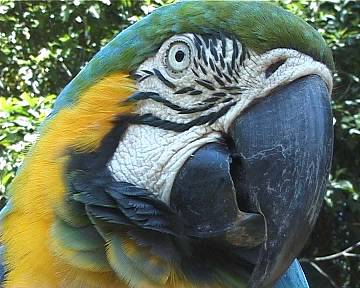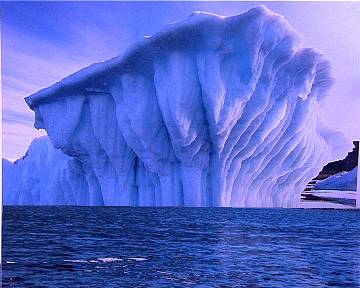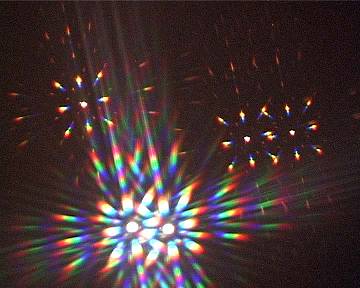
|
The world of non-commercial film and A-V |
Events Diary | Search | ||
| The Film and Video Institute | | ||||
The making of A Splash of Colour
"About time I made another movie", I thought. "I haven't made a 'proper' documentary (i.e. one not cobbled together from holiday footage) for some time, but what subject?"
My lifelong interest in matters-scientific naturally came to mind but, for most people, this tends to be a deadly boring topic. So, I had a challenge; think of something that could be of broader interest, and then find a way of presenting it in an accessible way.
The idea of a video on colour soon came to mind - it's all around us and it features in every one of our movies, but we take it for granted.

It was essential, though, to avoid producing an advanced physics lecture; the scientific content should be no deeper than those dimly-remembered facts from school-day science lessons. Hopefully, the content and layout of the final video speak for themselves - an easygoing exploration of the different ways in which colours are produced; illustrated, as much as possible, with striking visuals.
Many of the scenes were taken from my own stock footage. There was quite a good choice (we are all attracted to bright colours when filming) but, of course, many vital subjects were missing. Throughout the movie, I wanted to repeatedly include all the colours of the spectrum. (How many viewers actually notice this is another matter!) but good examples of some colours were in short supply. In particular, it was hard to find enough things that were blue. The film was conceived and largely completed in November and there are very few blue subjects at that time of year. It was also getting cold outside so my mind naturally turned to sitting in front of a nice warm computer and creating the missing scenes by 'cheating'.
"What's blue and eye-catching?" I thought, "Icebergs. Big icebergs!" Small problem, though - I had no shots of icebergs. It's hard to scale-up ice-cubes convincingly so, having discounted a trip to the Arctic, I went to the library. Lots of photos of icebergs floating majestically in the ocean, but the waves were not showing much sign of motion. 'Stills' were banned from the video, so I needed to get in some movement. Following another visit, this time to a local reservoir (where it was almost as cold as the Arctic!), I had some footage of rippling water and set about combining it with the still images of the icebergs. Adobe Premier's simple split-screen - with iceberg on top and reservoir below - was a start, but very unconvincing.
The next step was to superimpose an inverted view of the berg, to act as its reflection in the water. A simple still shot would not do, of course, and the 'reflection' was broken up into 'facets', by using one of Premiere's filters, and then made to ripple by using another.

Doing this two or three times (each with a different scale of faceting, and slowing down the larger-faceted clips - to make both small and large 'waves') gave a much more realistic effect. Finally, the whole scene was given a strong blue cast, by whopping application of the colour balance filter, and I had some blue scenes for the video.
Next problem - rainbows. When making a video about colours, it's hard to avoid rainbows, but they are few and far between in the Midlands during November. I can make a rainbow, I thought (good title for a song, too!) and started by drawing a series of coloured arcs, using Premiere's titling system. With hindsight, it would have been much easier to use different software, but we live and learn. It was easy to position and superimpose the rainbow on a background scene but more was needed. Firstly, in real life, the ends of rainbows are rather fuzzy (it's the pot of gold that causes this, I'm told) and I could not get them to look right. Once again, I cheated and covered up the difficult bits with some superimposed, 'blue-screened' leaves. Secondly, we only get rainbows when it's raining. So, I waited until night and set up the camera in the garden - pointing at a dark patch. With the aid of three 1000W lights and a hosepipe, I managed to get some 'rain' against a dark background. I also managed to get very wet and cold, as well as convincing the neighbours that I am utterly mad! Premiere's 'luminance' key then allowed superimposition of the 'rain' into the scene, giving a result that is unlikely to fool anyone but which, hopefully, still makes the point.
Apart from a bit of 'enhancement', most of the other scenes were pretty much shot as they happened. That's not to say that it all went easily of course. For example, we've all seen the rainbow colours made by a thin layer of oil or grease on water. You try and make it happen for the camera, though, and nature refuses to cooperate. Olive oil, bacon grease, white spirit - you name it - none wanted to play! It was a grill pan, waiting in the sink to be washed, that eventually heeded the call to movie stardom and, without any prompting, put in an acceptable performance.
I don't really like doing my own narration because, like most people, I think that my voice is very inadequate. All the major movie stars were booked up in November, however, and I was forced into self-reliance. Knowing your weaknesses probably helps (in my case there are many, including poor diction and lack of treble) but practice and a concerted effort to correct shortcomings does help a lot.

It's not too hard to improve your voice a little when reading a commentary; the real difficulty is sustaining it during the whole recording. Too often I found that voice quality was changing all the time so that some passages needed to be re-done ten times or more. Just once, in my movie-making career, have I been able to use a professional voiceover artist. He was brilliant and I realise that these people are well worth their fees. Some charge only a few hundred pounds; still too much for most of us, I realise, and others demand several thousand, but it does make a huge difference.
I'm still surprised at the success that the video has enjoyed but hope that it has shed a little light, of all colours, on a subject that we all experience but often fail to fully appreciate.
- Alan Atkinson (Email via webmaster@theiac.org.uk)
This article was written for the July/August issue of CEMRIAC News magazine
and appears here by kind permission of the author and editor.
The film has been selected as part of the UK programme for the UNICA 2002 Festival.
Share your passions.

Share your stories.